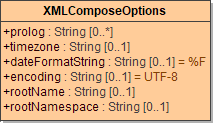- Created by Kirstin Seidel-Gebert, last modified by Annegret Bernhardt on Jan 26, 2024
| Syntax | set aBlob = anObject.classToXML() set aBlob = anObject.classToXML(options) | ||||||||||||||||||||||||||||
|---|---|---|---|---|---|---|---|---|---|---|---|---|---|---|---|---|---|---|---|---|---|---|---|---|---|---|---|---|---|
| Semantics | The operation takes any object ( By default the following mapping rules apply: These default rules can be overridden by using <<XMLElement>>, <<XMLAttribute>> and <<XMLCharacters>> stereotypes on UML class attributes and UML association ends. The WSDL/XSD importer will not set these XML stereotypes, hence A conversion with operation | ||||||||||||||||||||||||||||
| Substitutables | anObject | Target object can be any complex object. However, simple types and arrays are not supported, since they do not map naturally to a well formed XML document. | |||||||||||||||||||||||||||
options | This optional parameter is an object of type XMLComposeOptions. Its attributes are: Bridge 7 Name of the generated XML root element. Use this tagged value to override the default behavior specified on the composite (see Frontend Components). Bridges of version 6 do not support this tagged value. The generated root element will be named after the variable name of the target object of the operation ( | ||||||||||||||||||||||||||||
| Examples | set xmlBlob = myAddress.classToXML(); | ||||||||||||||||||||||||||||
Example File (Builder project E2E Action Language/XML):
The following action script serializes an object of type Address provided, that you have defined an input object node named myAddress of type Address in the activity diagram.
set xmlBlob = myAddress.classToXML();
The sample XML document below illustrates the mapping executed by classToXML(). The object myAddress of type Address (see class diagram) is mapped to an XML document as depicted in the following XML document:
<myAddress id="myAddressID"> <street>Lautengartenstr. 12</street> <city>Basel</city> </myAddress>
Note, that the XML element myAddress is of type Address. This type has the UML attribute id, which corresponds to the XML attribute id. Additionally, the XML elements street and city are mapped to the association ends city respectively street. Both are having the type String.
